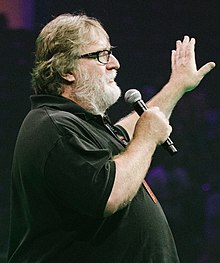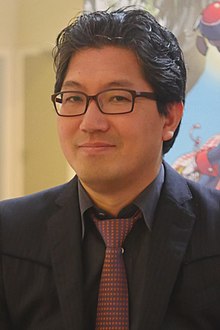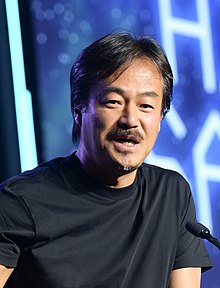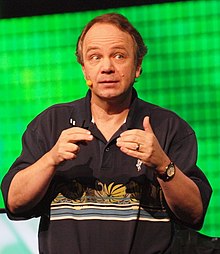Portal:Video games
Portal maintenance status: (April 2019)
|
The Video Games Portal

A video game, also known as a computer game or just a game, is an electronic game that involves interaction with a user interface or input device (such as a joystick, controller, keyboard, or motion sensing device) to generate visual feedback from a display device, most commonly shown in a video format on a television set, computer monitor, flat-panel display or touchscreen on handheld devices, or a virtual reality headset. Most modern video games are audiovisual, with audio complement delivered through speakers or headphones, and sometimes also with other types of sensory feedback (e.g., haptic technology that provides tactile sensations). Some video games also allow microphone and webcam inputs for in-game chatting and livestreaming.
Video games are typically categorized according to their hardware platform, which traditionally includes arcade video games, console games, and computer (PC) games; the latter also encompasses LAN games, online games, and browser games. More recently, the video game industry has expanded onto mobile gaming through mobile devices (such as smartphones and tablet computers), virtual and augmented reality systems, and remote cloud gaming. Video games are also classified into a wide range of genres based on their style of gameplay and target audience. (Full article...)
Featured articles – load new batch
-
Image 1Flower is a video game developed by Thatgamecompany and published by Sony Computer Entertainment. It was designed by Jenova Chen and Nicholas Clark and was released in February 2009 on the PlayStation 3, via the PlayStation Network. PlayStation 4 and PlayStation Vita versions of the game were ported by Bluepoint Games and released in November 2013. An iOS version was released in September 2017, and a Windows version was released in February 2019, both published by Annapurna Interactive. The game was intended as a "spiritual successor" to Flow, a previous title by Chen and Thatgamecompany. In Flower, the player controls the wind, blowing a flower petal through the air using the movement of the game controller. Flying close to flowers results in the player's petal being followed by other flower petals. Approaching flowers may also have side-effects on the game world, such as bringing vibrant color to previously dead fields or activating stationary wind turbines. The game features no text or dialogue, forming a narrative arc primarily through visual representation and emotional cues.
Flower was primarily intended to arouse positive emotions in the player, rather than to be a challenging and "fun" game. This focus was sparked by Chen, who felt that the primary purpose of entertainment products like video games was the feelings that they evoked in the audience and that the emotional range of most games was very limited. The team viewed their efforts as creating a work of art, removing gameplay elements and mechanics that were not provoking the desired response in the players. The music, composed by Vincent Diamante, dynamically responds to the player's actions and corresponds with the emotional cues in the game. Flower was a critical success, to the surprise of the developers. Reviewers praised the game's music, visuals, and gameplay, calling it a unique and compelling emotional experience. It was named the "best independent game of 2009" at the Spike Video Game Awards, and won the "Casual Game of the Year" award by the Academy of Interactive Arts and Sciences. (Full article...) -
Image 2Tony Hawk's Underground is a 2003 skateboarding video game and the fifth entry in the Tony Hawk's series, following Tony Hawk's Pro Skater 4. It was developed by Neversoft and published by Activision for the GameCube, PlayStation 2, Xbox, and Game Boy Advance. In 2004, it was published for Windows in Australia and New Zealand as a budget release.
Underground is built upon the skateboarding formula of previous Tony Hawk's games: the player explores levels and completes goals while performing tricks. It features a new focus on customization; the player, instead of selecting a professional skater, creates a custom character. Underground adds the ability for players to dismount their boards and explore on foot. The plot follows the player character and their friend Eric Sparrow as the two become professionals and grow apart.
Underground was developed with a theme of individuality which was manifested in the extensive character customization options, the presence of a narrative, and the product's characterization as an adventure game. Real world professional skateboarders contributed their experiences to the plot. Underground was a major critical and commercial success, with reviewers praising its wide appeal, soundtrack, customization, multiplayer, and storyline. The graphics and the controls for driving vehicles and walking were less well received. Underground's PlayStation 2 version had sold 2.11 million copies in the United States by December 2007. A sequel, Tony Hawk's Underground 2, followed in 2004. (Full article...) -
Image 3Wipeout 2048 is a 2012 racing game developed by Studio Liverpool and published by Sony Computer Entertainment in which players pilot anti-gravity ships around futuristic racetracks. It was a launch game for the PlayStation Vita handheld system and is the ninth instalment of the Wipeout series following Wipeout HD (2008) and Wipeout Pulse (2007). It was also the last game to be developed by Studio Liverpool before its closure as well as the last mainline Wipeout title.
As the title implies, Wipeout 2048 is a prequel to the original 1995 Wipeout and is set in the years 2048, 2049, and 2050. The game was designed as a testbed for the PlayStation Vita. During development, Studio Liverpool staff sent feedback about aspects that could affect the Vita design to Sony; some of their suggestions, including the addition of a rear touchscreen and two separate joysticks, were added to the Vita. Wipeout 2048 preserves some technical aspects of its predecessor game Wipeout HD, including downloadable content (DLC), online multiplayer mode, and cross-platform play with PlayStation 3 owners running Wipeout HD.
Wipeout 2048 received mainly positive reviews; critics said its graphics and visuals showcased the power of the then-new PlayStation Vita but criticised its long loading times and other technical problems. The game, together with Wipeout HD and its Fury expansion, was remastered for PlayStation 4 and released as Wipeout Omega Collection in 2017. (Full article...) -
Image 4Alleyway is a 1989 video game developed by Nintendo and Intelligent Systems and published by Nintendo as a global launch title for the Game Boy. It is a Breakout clone and one of the first four games developed and released for the system. The game was released first in Japan in 1989, in North America later that year, and in Europe in 1990. It was later re-released for the Nintendo 3DS Virtual Console in June 2011, and on the Nintendo Switch Online service in May 2024.
The name Alleyway references the in-game gateway that the player's spaceship (represented as a paddle) must pass through. While Alleyway is a portable clone of Breakout, it adds several features, including alternating stages, bonus rounds, and hazards for the player at later levels. While the game's original box art featured an unidentifiable protagonist, later international releases of the game replaced the character with Mario. Alleyway was released with limited advertising, receiving moderate to low scores from reviewers who compared it to games like Arkanoid. (Full article...) -
Image 5The Dark Pictures Anthology: House of Ashes is a 2021 interactive drama and survival horror video game developed by Supermassive Games and published by Bandai Namco Entertainment. It is the third game of the first season of The Dark Pictures Anthology. The game features a multilinear plot in which decisions can significantly alter the trajectory of the story and change the relationships between the five playable protagonists; some lead to their permanent deaths. House of Ashes is set during the 2003 invasion of Iraq and follows five characters—four Americans working for the US Armed Forces and one Iraqi Republican Guard—who must escape from an underground Akkadian temple and survive the vampiric creatures that infest the area. Ashley Tisdale, who plays CIA operative Rachel King, was marketed as the game's leading actress. Jason Graves, a long-time collaborator with Supermassive for the series, composed the soundtrack during COVID-19 lockdowns in the United Kingdom.
Reappearing in House of Ashes are staple mechanics of The Dark Pictures Anthology, such as quick time events (QTEs), two single-player and two multiplayer modes, and collectibles that allow players to see visions of possible future events. New features include a more interactive camera system, a handheld light source for easier navigation, and three difficulty levels to manage QTEs. The films Aliens, Predator, and The Descent, as well as the H. P. Lovecraft novella At the Mountains of Madness and the myth of the Curse of Akkad were the main influences for the game. The creatures were made using motion capture and hand animation, and the temple's design was inspired by ancient Mesopotamian architecture. Military specialists and Arabic speakers were consulted to ensure a faithful depiction of the war.
House of Ashes was released for PlayStation 4, PlayStation 5, Windows, Xbox One, and Xbox Series X/S on 22 October 2021, to mixed reviews. Several critics deemed it an improvement from the previous two instalments in the anthology, and points of praise included the replay value, QTE intensity, cinematography, multiplayer modes, and likeability of the Iraqi character. Critiques were directed towards the game's pacing, scare factor, facial animations, texture and animation glitches, and handling of the Iraq War. The fourth game in the series and the season one finale, The Devil in Me, was revealed in a teaser trailer at the end of House of Ashes and released on 18 November 2022. (Full article...) -
Image 6Nights: Journey of Dreams is an action video game developed by Sega Studios USA and published by Sega for the Wii. The sequel to the 1996 Sega Saturn title Nights into Dreams, it was released in Japan and North America in December 2007, and in Australia and Europe the following month. The story follows two children, William Taylor and Helen Cartwright, who enter a dream world called Nightopia. When their nightmares come to life, they enlist the help of Nights, an exiled "Nightmaren", as they journey through Nightopia to stop the evil ruler Wizeman from escaping into the real world.
As with its predecessor, gameplay is centred around Nights flying through the dreams of the two children. The main objective of the game is to fly through rings while gathering enough keys to proceed to the next level. Development of Journey of Dreams began shortly after the release of Shadow the Hedgehog in 2005, and was headed by Sonic Team veteran Takashi Iizuka. The team took steps to ensure that the game stayed faithful to the original, while incorporating a variety of new mechanics and features. The game's setting was designed to resemble England, especially parts of London.
Journey of Dreams received mixed reviews; critics praised the game's colourful visuals, boss battles, soundtrack, and special effects, but criticised its controls, camera, aesthetics, and aspects of its gameplay. Despite the mixed reception, Iizuka said that he would be interested in making a third Nights game, should Sega commission one. (Full article...) -
Image 7Paper Mario: The Origami King is a 2020 role-playing video game developed by Intelligent Systems and published by Nintendo for the Nintendo Switch console. Following Paper Mario: Color Splash (2016), it is the sixth game in the Paper Mario series, which is part of the larger Mario franchise. The story follows Mario and his friends as he sets out on a journey to prevent the Mushroom Kingdom from being transformed into origami. To do so, Mario must free Princess Peach's castle from five decorative streamers that extend across the kingdom.
The Origami King features cross-genre gameplay, blending elements of action-adventure, role-playing (RPG), and puzzle games. Controlling Mario, the player explores a large overworld and fights enemies in a turn-based style that uses a ring-based puzzle system. In combat, enemies are scattered on a circle stylized like a dartboard separated into four rings and additional columns. The player can rotate the rings horizontally and vertically to organize the enemies into patterns that result in being able to clear them more quickly.
The Origami King's development team emphasized innovation to a greater extent than previous games in the series. Anticipating an inability to satisfy every fan, Intelligent Systems gravitated towards creating entirely new concepts. Origami and confetti were used as new variants of paper-themed concepts. The developers changed the traditional linear gameplay to an open world format and used enemies uninvolved with the Mario franchise. Nintendo intended to announce the game at E3 2020 as part of the 35th anniversary of Super Mario Bros. (1985), but due to the cancellation of the expo, the game was revealed separately from the anniversary celebrations. (Full article...) -
Image 8Doom is a 2016 first-person shooter video game developed by id Software and published by Bethesda Softworks. The game is the first major installment in the Doom series since 2004's Doom 3 and was a reboot of the franchise. It was released for PlayStation 4, Windows, and Xbox One in May 2016. A port for Nintendo Switch was co-developed with Panic Button and released in November 2017, and a version for Google Stadia was released in August 2020. Players take the role of an unnamed space marine, known as the "Doom Slayer", as he battles demonic forces within an energy-mining facility on Mars and in Hell.
Doom was announced as Doom 4 in 2008, and that version underwent an extensive development cycle with different builds and designs before the game was restarted in 2011 and re-revealed as simply Doom in 2014. It was tested by customers who pre-ordered the 2014 MachineGames game Wolfenstein: The New Order and the general public. Mick Gordon composed the music, with contributions by Richard Devine. The game also has an online multiplayer component and a level editor known as "SnapMap", co-developed with Certain Affinity and Escalation Studios respectively.
Doom was well received by critics and players. The single-player campaign, graphics, soundtrack, and gameplay received considerable praise, whereas the multiplayer mode drew significant criticism. It was the second best-selling video game in North America and the United Kingdom in the week of its release and sold over 500,000 copies for PCs by the end of May 2016. A sequel, Doom Eternal, was released in March 2020. A prequel, Doom: The Dark Ages, is set to be released in 2025. (Full article...) -
Image 9Journey is an indie adventure game developed by Thatgamecompany, published by Sony Computer Entertainment, and directed by Jenova Chen. It was released for the PlayStation 3 via PlayStation Network in March 2012 and ported to PlayStation 4 in July 2015. It was later ported to Windows in June 2019 and iOS in August 2019.
In Journey, the player controls a robed figure in a vast desert, traveling towards a mountain in the distance. Other players on the same journey can be discovered, and two players can meet and assist each other, but they cannot communicate via speech or text and cannot see each other's names until after the game's credits. The only form of communication between the two is a musical chime, which transforms dull pieces of cloth found throughout the levels into vibrant red, affecting the game world and allowing the player to progress through the levels. The developers sought to evoke in the player a sense of smallness and wonder and to forge an emotional connection between them and the anonymous players they meet along the way. The music, composed by Austin Wintory, dynamically responds to the player's actions, building a single theme to represent the game's emotional arc throughout the story.
Reviewers of the game praised the visual and auditory art as well as the sense of companionship created by playing with a stranger, calling it a moving and emotional experience, and have since listed it as one of the greatest video games of all time. Journey won several "game of the year" awards and received several other awards and nominations, including a Best Score Soundtrack for Visual Media nomination for the 2013 Grammy Awards. A retail "Collector's Edition", including Journey, Thatgamecompany's two previous titles, and additional media, was released in August 2012. (Full article...) -
Image 10In the Halo universe, an Arbiter is a ceremonial, religious, and political rank bestowed upon Covenant Elites. In the 2004 video game Halo 2, the rank is given to a disgraced commander named Thel 'Vadam as a way to atone for his failures. Although the Arbiter is intended to die serving the Covenant leadership, the High Prophets, he survives his missions and the Prophets' subsequent betrayal of his kind. When he learns that the Prophets' plans would doom all sentient life in the galaxy, the Arbiter allies with the Covenant's enemies (humans) and stops the ringworld Halo from being activated. The Arbiter is a playable character in Halo 2 and its 2007 sequel Halo 3. The character also appears in Halo 5: Guardians and additional expanded universe material. A different Arbiter, Ripa 'Moramee appears in the 2009 real-time strategy game Halo Wars, which takes place 20 years before the events of the main trilogy.
The appearance of the Arbiter in Halo 2 and the change in perspective from the main human protagonist Master Chief to a former enemy was a plot twist Halo developer Bungie kept highly secret. The character's name was changed from "Dervish" after concerns that the name reinforced a perceived United States-versus-Islam allegory in the game's plot. Actor Keith David lends his voice to the character in Halo 2, 3, and 5, while David Sobolov voices the Arbiter of Halo Wars.
The Arbiter has appeared as action figures and other collectibles and marketing, in addition to appearances in the games. Bungie intended the sudden point of view switch to a member of the Covenant as a plot twist that no one would have seen coming, but the character in particular and the humanization of the Covenant in general was not evenly received by critics and fans. Computer and Video Games derided the Arbiter's missions as some of the worst parts of Halo 2. Conversely, IGN lamented the loss of the Arbiter's story in Halo 3 and missed the added dimension the character provided to the story. (Full article...)
Did you know... - show different entries
- ... that for at least 90 minutes, Mori Calliope livestreamed herself begging video game developer Atlus to allow her to stream their game Persona 3?
- ... that the game designer of the video game Hades said that the characters were attractive "because Jen Zee"?
- ... that the 1987 video game Oriental Hero was panned as "so incredibly bad it's almost worth a look"?
- ... that the science-fiction video game The Anacrusis is named after a musical term?
- ... that Kamibox's video game A Joke That's Worth $0.99 is permanently on special offer because Itch.io does not allow $0.99 as a regular price?
- ... that the success of Kingdom Rush prompted plans to grow the video game industry of Uruguay?
- ... that MicroProse was formed to publish Hellcat Ace after Sid Meier boasted that he could design a better video game than Red Baron in a week?
- ... that approximately 85 percent of Manhattan was recreated for the 2008 video game The Incredible Hulk?
- ... that the contrabass trombone has experienced a revival in film music and video game soundtracks?
- ... that the name of the video game mod series Bomba Patch was inspired by éclairs?
- ... that development on the video game Expeditions: Rome was not affected by lockdowns from the COVID-19 pandemic because the developer was already split between Copenhagen and Istanbul?
- ... that Rockstar Vienna was the largest video game developer in Austria when it closed in 2006?
Selected biography – load new batch
-
Image 1
Gabe Logan Newell (born November 3, 1962), also known by his nickname Gaben, is an American businessman who is the president and co-founder of the video game company Valve Corporation.
Newell was born in Colorado and grew up in Davis, California. He attended Harvard University in the early 1980s but dropped out to join Microsoft, where he helped create the first versions of the Windows operating system. He and another employee, Mike Harrington, left Microsoft in 1996 to found Valve, and funded the development of their first game, Half-Life (1998). Harrington left in 2000. (Full article...) -
Image 2
Anita Sarkeesian (/sɑːrˈkiːziən/ sar-KEE-zee-ən; born 1983) is a Canadian-American feminist media critic. She is the founder of Feminist Frequency, a website that hosts videos and commentary analyzing portrayals of women in popular culture. Her video series Tropes vs. Women in Video Games, examines tropes in the depiction of female video game characters.
Media scholar Soraya Murray calls Sarkeesian emblematic of "a burgeoning organized feminist critique" of stereotyped and objectified portrayals of women in video games.
In 2012, Sarkeesian was targeted by an online harassment campaign following her launch of a Kickstarter project to fund the Tropes vs. Women in Video Games series. The threats and harassment generated widespread media attention, and resulted in the project far exceeding its funding goal. The media coverage placed Sarkeesian at the center of discussions about misogyny in video game culture and online harassment. She has spoken to TEDxWomen, XOXO Festival, and the United Nations' Broadband Working Group on Gender, and appeared on The Colbert Report discussing her experiences of harassment and the challenge of attempting to improve gender inclusivity in gaming culture and the media. (Full article...) -
Image 3Morhaime at BlizzCon 2009
Michael Morhaime (born November 3, 1967) is an American video game developer and entrepreneur. He is the chief executive officer (CEO) and founder of Dreamhaven, located in Irvine, California. Morhaime is best known as the co-founder and the former president of Blizzard Entertainment, a subsidiary of Activision Blizzard, Inc., that was founded in 1991 as Silicon & Synapse. He served on the Vivendi Games executive committee from January 1999, when Blizzard Entertainment, Inc. became a subsidiary of Vivendi Games, until July 2008. (Full article...) -
Image 4Yuji Naka (中 裕司, Naka Yūji, born September 17, 1965), credited in some games as YU2, is a former Japanese video game programmer, designer and producer. He is the co-creator of the Sonic the Hedgehog series and was the president of Sonic Team at Sega until his departure in 2006.
Naka joined Sega in 1984 and worked on games including Girl's Garden (1985) and Phantasy Star II (1989). He was the lead programmer of the original Sonic the Hedgehog games on the Mega Drive in the early 1990s, which greatly increased Sega's market share. Naka developed Sonic the Hedgehog 2 (1992), Sonic the Hedgehog 3 (1994) and Sonic & Knuckles (1994) in California with Sega Technical Institute. (Full article...) -
Image 5Ken Kutaragi (久夛良木 健, Kutaragi Ken, born 2 August 1950) is a Japanese engineering technologist and businessman. He is the former chairman and CEO of Sony Interactive Entertainment (SIE), the video game division of Sony Group Corporation, and current president and CEO of Cyber AI Entertainment. He is known as "The Father of the PlayStation", as he oversaw the development of the original console and its successors and spinoffs, including the PlayStation 2, PlayStation Portable, and the PlayStation 3. He departed Sony in 2007, a year after the PlayStation 3 was released.Kutaragi with his Lifetime Achievement Award at the Game Developers Choice Awards 2014
He had also designed the sound processor for the Super Nintendo Entertainment System. With Sony, he designed the VLSI chip which works in conjunction with the PS1's RISC CPU to handle the graphics rendering. (Full article...) -
Image 6Hironobu Sakaguchi (坂口 博信, Sakaguchi Hironobu, born November 25, 1962) is a Japanese game designer, director, producer, and writer. Originally working for Square (later Square Enix) from 1983 to 2003, he departed the company and founded independent studio Mistwalker in 2004. He is known as the creator of the Final Fantasy franchise, in addition to other titles during his time at Square. At Mistwalker, he is known for creating the Blue Dragon and Terra Battle series among several standalone titles, moving away from home consoles and creating titles for mobile platforms.Sakaguchi at the 2015 Game Developers Choice Awards
Originally intending to become a musician, he briefly studied electronics and programming, joining Square as a part-time employee, then later a full-time employee when Square became an independent company in 1986. He led the development of several titles before helping to create the original Final Fantasy, which proved highly successful and cemented his status within the company. Following the financial failure of Final Fantasy: The Spirits Within, his debut as a film director, Sakaguchi withdrew from Square's management and eventually resigned in 2003. He continued his game career through Mistwalker, first co-developing projects through external partners and then smaller in-studio mobile projects. (Full article...) -
Image 7Persson at the 2016 Game Developers Conference
Markus Alexej Persson (/ˈpɪərsən/ ⓘ PEER-sən, Swedish: [ˈmǎrːkɵs ˈpæ̌ːʂɔn] ⓘ; born 1 June 1979), also known as Notch, is a Swedish video game programmer and designer. He is the creator of Minecraft, which is the best-selling video game in history. He founded the video game development company Mojang Studios in 2009.
Persson began developing video games at an early age. His commercial success began after he published an early version of Minecraft in 2009. Prior to the game's official retail release in 2011, it had sold over ten million copies. After this point Persson stood down as the lead designer and transferred his creative authority to Jens Bergensten. In September 2014 Persson announced on his personal website that he had concluded he "[didn't have the connection to his fans he thought he had]", that he had "become a symbol", and that he did not wish to be responsible for Mojang's increasingly large operation. He left Mojang in November of that year, selling his company to Microsoft reportedly for US$2.5 billion. The acquisition made Persson a billionaire. (Full article...) -
Image 8Nobuo Uematsu (植松 伸夫, Uematsu Nobuo, born March 21, 1959) is a Japanese composer and keyboardist best known for his contributions to the Final Fantasy video game series by Square Enix. A self-taught musician, he began playing the piano at the age of twelve, with English singer-songwriter Elton John as one of his biggest influences.
Uematsu joined Square in 1986, where he first met Final Fantasy creator Hironobu Sakaguchi. The two later worked together on many games at the company, most notably in the Final Fantasy series. After nearly two decades with Square, Uematsu left in 2004 to create his own production company and music label, Dog Ear Records. He has since composed music as a freelancer for other games, including ones developed by Square Enix and Sakaguchi's studio Mistwalker. (Full article...) -
Image 9Mitchell at a 2014 Twin Galaxies event
William James Mitchell Jr. (born July 16, 1965) is an American video game player. He achieved fame throughout the 1980s and 1990s by claiming numerous records on classic video games, including a perfect score on Pac-Man. Twin Galaxies and Guinness World Records recognized Mitchell as the holder of several records earned playing classic video games, and he has appeared in several documentaries on competitive gaming and retrogaming. However, in 2017, the legitimacy of a number of his records was called into question, leading to Twin Galaxies stripping Mitchell of his records.
Mitchell rose to national prominence in the 1980s when Life included him in a photo spread of game champions during the height of the golden age of arcade video games. In 1999, Mitchell was the first person to claim a perfect score of 3,333,360 points on the arcade game Pac-Man. A 2007 documentary, The King of Kong: A Fistful of Quarters, follows his attempts to maintain the highest score on Donkey Kong after being challenged by newcomer Steve Wiebe. (Full article...) -
Image 10Shinji Mikami (三上 真司, Mikami Shinji, born August 11, 1965) is a Japanese video game designer, director, and producer. Starting his career at Capcom in 1990, he has worked on many of the company's most successful games. He directed the first installment of the Resident Evil series in 1996 and the first installment of the Dino Crisis series in 1999, both survival horror games. He returned to Resident Evil to direct the remake of the first game in 2002 and the survival horror third-person shooter Resident Evil 4 in 2005. In 2006, he directed his final Capcom game God Hand, a beat 'em up action game. Mikami founded PlatinumGames in 2006 and directed the third-person shooter Vanquish in 2010. That same year he left the studio and founded a new studio Tango Gameworks and directed the survival horror game The Evil Within in 2014. He has also served the roles of producer and executive producer for many games. In 2023, he left the studio and founded a new studio KAMUY in 2024.
In 2009, he was chosen by IGN as one of the top 100 game creators of all time. (Full article...) -
Image 11Yuji Naka (中 裕司, Naka Yūji, born September 17, 1965), credited in some games as YU2, is a former Japanese video game programmer, designer and producer. He is the co-creator of the Sonic the Hedgehog series and was the president of Sonic Team at Sega until his departure in 2006.
Naka joined Sega in 1984 and worked on games including Girl's Garden (1985) and Phantasy Star II (1989). He was the lead programmer of the original Sonic the Hedgehog games on the Mega Drive in the early 1990s, which greatly increased Sega's market share. Naka developed Sonic the Hedgehog 2 (1992), Sonic the Hedgehog 3 (1994) and Sonic & Knuckles (1994) in California with Sega Technical Institute. (Full article...) -
Image 12Meier at the 2010 Game Developers Conference
Sidney K. Meier (/ˈmaɪər/ MIRE; born February 24, 1954) is an American businessman and computer programmer. A programmer, designer, and producer of several strategy video games and simulation video games, including the Civilization series, Meier co-founded MicroProse in 1982 with Bill Stealey and is the Director of Creative Development of Firaxis Games, which he co-founded with Jeff Briggs and Brian Reynolds in 1996. For his contributions to the video game industry, Meier was inducted into the Academy of Interactive Arts and Sciences Hall of Fame. (Full article...) -
Image 13
Jeremy Soule (/soʊl/ SOHL; born December 19, 1975) is an American composer of soundtracks for film, television, and video games. He has composed soundtracks for over 60 games and over a dozen other works during his career, including The Elder Scrolls, Guild Wars, Icewind Dale, and the Harry Potter series.
He became an employee of Square in 1994 after several years of private composition studies. After finishing the soundtrack to Secret of Evermore in 1995, he left to join Humongous Entertainment, where he composed for several children's games as well as Total Annihilation, his first award-winning score. In 2000, he left to form his own music production company, Soule Media, later called Artistry Entertainment. In 2005, he founded DirectSong, a record label that published digital versions of his soundtracks as well as those of classical composers. DirectSong remained active until 2019. (Full article...) -
Image 14
Richard Allan Bartle (born 10 January 1960) is a British writer, professor and game researcher in the massively multiplayer online game industry. He co-created MUD1 (the first MUD) in 1978, and is the author of the 2003 book Designing Virtual Worlds. (Full article...) -
Image 15
Timothy John Schafer (born July 26, 1967) is an American video game designer. He founded Double Fine Productions in July 2000, after having spent over a decade at LucasArts. Schafer is best known as the designer of critically acclaimed games Full Throttle, Grim Fandango, Psychonauts, Brütal Legend and Broken Age, co-designer of Day of the Tentacle, and assistant designer on The Secret of Monkey Island and Monkey Island 2: LeChuck's Revenge. He is well known in the video game industry for his storytelling and comedic writing style, and has been given both a Lifetime Achievement Award from the Game Developers Choice Awards, and a BAFTA Fellowship for his contributions to the industry. (Full article...) -
Image 16Meier at the 2010 Game Developers Conference
Sidney K. Meier (/ˈmaɪər/ MIRE; born February 24, 1954) is an American businessman and computer programmer. A programmer, designer, and producer of several strategy video games and simulation video games, including the Civilization series, Meier co-founded MicroProse in 1982 with Bill Stealey and is the Director of Creative Development of Firaxis Games, which he co-founded with Jeff Briggs and Brian Reynolds in 1996. For his contributions to the video game industry, Meier was inducted into the Academy of Interactive Arts and Sciences Hall of Fame. (Full article...) -
Image 17
Geoff Keighley (/ˈkiːli/; born (1978-06-24)June 24, 1978) is a Canadian video game journalist and television presenter, best known for his role as the host of several video game industry conferences and presentations. He is the executive producer and host of The Game Awards since its inception in 2014, having previously served as the executive producer of the Spike Video Game Awards. He also hosts and produces Summer Game Fest, and has hosted live events for trades fairs Gamescom and the now-defunct E3.
He previously hosted the video game show GameTrailers TV, and G4tv.com. Keighley is also a freelance writer whose work has appeared in Kotaku among other publications. His multi-media series The Final Hours, originally an article series published by GameSpot, features in-depth interviews and behind-the-scenes with developers of popular franchises like Portal, Mass Effect and Tomb Raider. (Full article...) -
Image 18Martinet at GalaxyCon Richmond 2024
Charles Andre Martinet (born September 17, 1955) is an American actor. Martinet created the voices of both Mario and Luigi in the Super Mario video game series, portraying them from 1992 to 2023. He also voiced other characters in the series such as Wario, Waluigi, and the baby equivalents of Mario and Luigi, prior to stepping down as voice actor to become an official brand ambassador for the series.
Martinet is also known for his portrayal of Paarthurnax in 2011's The Elder Scrolls V: Skyrim, as well as Magenta in 2022's Dragon Ball Super: Super Hero. (Full article...) -
Image 19
Roberta Lynn Williams (née Heuer; born February 16, 1953) is an American video game designer and writer, who co-founded Sierra On-Line with her husband, game developer Ken Williams. In 1980, her first game, Mystery House, became a modest commercial success; it is credited as the first graphic adventure game. She is also known for creating and maintaining the King's Quest series, as well as designing the full motion video game Phantasmagoria in 1995.
Sierra was acquired by CUC International in 1996, leading to layoffs and management changes. Williams took a brief sabbatical, and returned to the company in a game design role, but grew increasingly frustrated with CUC's creative and business decisions. After the release of King's Quest: Mask of Eternity in 1998, she left the game industry in 1999 and focused her retirement on traveling and writing historical fiction. In 2021 she released her historical novel, Farewell to Tara. Soon after, she returned to game development with the 3D remake of the classic adventure game Colossal Cave Adventure, released in January 2023 as Colossal Cave. (Full article...) -
Image 20Yu Suzuki (鈴木 裕, Suzuki Yū, born June 10, 1958) is a Japanese game designer, producer, programmer, and engineer, who headed Sega's AM2 team for 18 years. Considered one of the first auteurs of video games, he has been responsible for a number of Sega's arcade hits, including three-dimensional sprite-scaling games that used "taikan" motion simulator arcade cabinets, such as Hang-On, Space Harrier, Out Run and After Burner, and pioneering polygonal 3D games such as Virtua Racing and Virtua Fighter, which are some of the games besides others from rival companies during that era credited with popularizing 3D graphics in video games; as well as the critically acclaimed Shenmue series. As a hardware engineer, he led the development of various arcade system boards, including the Sega Space Harrier, Model 1, Model 2 and Model 3, and was involved in the technical development of the Dreamcast console and its corresponding NAOMI arcade hardware.Suzuki at the 2011 Game Developers Conference
In 2003, Suzuki became the sixth person to be inducted into the Academy of Interactive Arts and Sciences' Hall of Fame. IGN listed him at #9 in their Top 100 Game Creators of All Time list. In 2011, he received the Pioneer Award at the Game Developers Choice Awards. (Full article...) -
Image 21Gunpei Yokoi (横井 軍平, Yokoi Gunpei, 10 September 1941 – 4 October 1997), sometimes transliterated as Gumpei Yokoi, was a Japanese toy maker and video game designer. As a long-time Nintendo employee, he was best known as creator of the Game & Watch handheld system, inventor of the cross-shaped Control Pad, the original designer of the Game Boy, and producer of a few long-running and critically acclaimed video game franchises such as Metroid and Kid Icarus. (Full article...)
-
Image 22Romero at the Game Developers Conference in 2022
Alfonso John Romero (born October 28, 1967) is an American video game developer. He co-founded id Software and designed their early games, including Wolfenstein 3D (1992), Doom (1993), Doom II (1994), Hexen (1995) and Quake (1996). His designs and development tools, along with programming techniques developed by the id programmer John Carmack, popularized the first-person shooter (FPS) genre. Romero is also credited with coining the multiplayer term "deathmatch".
Following disputes with Carmack, Romero was fired from id in 1996. He co-founded a new studio, Ion Storm, and directed the FPS Daikatana (2000), which was a critical and commercial failure. Romero departed Ion Storm in 2001. In July 2001, he and another former id employee, Tom Hall, founded Monkeystone Games to develop games for mobile devices. (Full article...) -
Image 23Tokuro Fujiwara (藤原 得郎, Fujiwara Tokurō, born April 7, 1961), sometimes credited as Professor F or Arthur King, is a Japanese video game designer, involved in the development of many classic Capcom video games. He directed early Capcom titles such as the run-and-gun shooter Commando (1985), the platformers Ghosts 'n Goblins (1985) and Bionic Commando (1987), and the survival horror game Sweet Home (1989). He was also a main producer for the Mega Man series and worked on the CP System arcade game Strider (1989). He also conceived of Resident Evil as a remake of his earlier game Sweet Home and worked on the game as general producer. He worked as the general manager of the Capcom Console Games Division from 1988 to 1996.
After working at Capcom for thirteen years, he left the company to form his own studio, Whoopee Camp. His latest game was Ghosts 'n Goblins Resurrection for former employer Capcom. He is notorious for making his titles difficult for the average video game player and strict personality among peers. IGN listed Fujiwara at number 13 in its "Top 100 Game Creators of All Time" list. (Full article...) -
Image 24
Felix Arvid Ulf Kjellberg (/ˈʃɛlbɜːrɡ/ SHEL-burg, Swedish: [ˈfěːlɪks ˈǎrːvɪd ɵlf ˈɕɛ̂lːbærj] ⓘ; born 24 October 1989), better known as PewDiePie (/ˈpjuːdiːpaɪ/ PEW-dee-py), is a Swedish YouTuber known for his comedic videos. Kjellberg's popularity on YouTube and extensive media coverage has made him one of the most noted online personalities and content creators. He has been portrayed in media as a figurehead for YouTube, especially in the genre of gaming.
Born and raised in Gothenburg, Kjellberg registered his YouTube channel "PewDiePie" in 2010, primarily posting Let's Play videos of horror and action video games. His channel gained a substantial following and was one of the fastest growing channels in 2012 and 2013, before becoming the most-subscribed on YouTube on 15 August 2013. From 29 December 2014 to 14 February 2017, Kjellberg's channel was also the most-viewed on the platform. During this period, his content shifted focus from Let's Plays and diversified to include vlogs, comedy shorts, formatted shows, and music videos. (Full article...) -
Image 25Carmack at the 2017 Game Developers Choice Awards
John D. Carmack II (born August 21, 1970) is an American computer programmer and video game developer. He co-founded the video game company id Software and was the lead programmer of its 1990s games Commander Keen, Wolfenstein 3D, Doom, Quake, and their sequels. Carmack made innovations in 3D computer graphics, such as his Carmack's Reverse algorithm for shadow volumes.
In 2013, he resigned from id Software to work full-time at Oculus VR as their CTO. In 2019, he reduced his role to Consulting CTO so he could allocate more time toward artificial general intelligence (AGI). In 2022, he left Oculus to work on his AGI startup, Keen Technologies. (Full article...)
Selected image - show another
Recent video game-related events
- September 12, 2024 – 2023–2024 video game industry layoffs
- Microsoft announces that it will lay off 650 Microsoft Gaming employees as part of cuts to its workforce. (Variety)
- August 15, 2024 –
- American video game magazine Game Informer discontinues publication after 33 years. The magazine's website is also shut down. (BBC News)
- May 24, 2024 – Uvalde school shooting
- Families in Uvalde, Texas, U.S., file a lawsuit against Daniel Defense and Activision Blizzard for creating the DDM4 V7 gun and promoting the weapon through the game Call of Duty, respectively. They also sue Meta Platforms for owning Instagram, which was used by the gunman. (AP)
Topics
Early history of video games (1947-1971) | |
|---|---|
| Analog and lightbulb games |
|
| Early Chess programs |
|
| Early mainframe games |
|
| First arcade games |
|
| People | |
| By platform | |
|---|---|
| By console generation | |
Video games by platform | |||||
|---|---|---|---|---|---|
| |||||
| Action |
| ||||||||||
|---|---|---|---|---|---|---|---|---|---|---|---|
| Action-adventure | |||||||||||
| Adventure | |||||||||||
| Digital tabletop | |||||||||||
| Puzzle | |||||||||||
| Role-playing | |||||||||||
| Simulation |
| ||||||||||
| Strategy | |||||||||||
| Other genres | |||||||||||
| Related concepts |
| ||||||||||
Video games by country | |
|---|---|
| Africa | |
| Americas | |
| Asia | |
| Europe | |
| Oceania | |
Best-selling video game hardware and software | |||||||||
|---|---|---|---|---|---|---|---|---|---|
| General | |||||||||
| Best-selling video games by platform |
| ||||||||
Video game concepts | |
|---|---|
| Attributes | |
| Characters | |
| Mechanics |
|
| Scenery | |
| Movement techniques | |
| Forms of play | |
| Game modes | |
| Game-specific | |
|---|---|
| Harassment and workplace misconduct | |
| Other controversies | |
| Social aspects | |
| Legal | |
Featured topics
Related portals
Categories
Things you can do
In other Wikimedia projects
The following Wikimedia Foundation sister projects provide more on this subject:
-
Commons
Free media repository -
Wikibooks
Free textbooks and manuals -
Wikidata
Free knowledge base -
Wikinews
Free-content news -
Wikiquote
Collection of quotations -
Wikisource
Free-content library -
Wikiversity
Free learning tools -
Wiktionary
Dictionary and thesaurus
- Pages using the Phonos extension
- Pages including recorded pronunciations
- Pages with Swedish IPA
- Portals with triaged subpages from April 2019
- All portals with triaged subpages
- Portals with no named maintainer
- Automated article-slideshow portals with 201–500 articles in article list
- Automated article-slideshow portals with less than 2 articles in article list
- Random portal component with over 50 available image subpages
- Pages using div col with small parameter
- Portals needing placement of incoming links
- Redirect targets of redirected portals with existing subpages












































